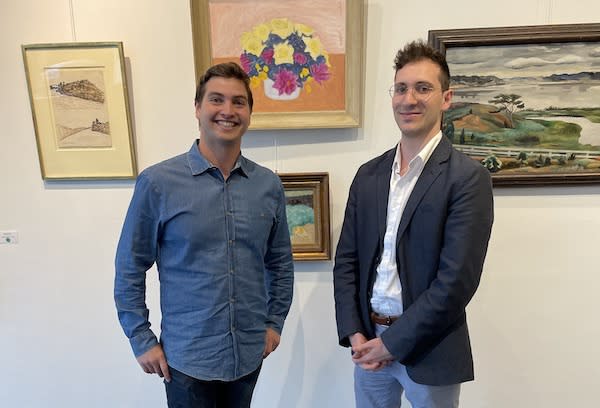Mercedes Matter was born in New York in 1913. Her father, the American modernist Arthur B. Carles, had studied with Matisse. Her mother, Mercedes de Cordoba, was a model for Edward Steichen. Ms. Matter grew up in Philadelphia, New York and Europe.
She began painting under her father's supervision at age 6, and studied art at Bennett College in Millbrook, N.Y., and then in New York City with Maurice Sterne, Alexander Archipenko and Hans Hofmann.
In the late 1930's, she was an original member of the American Abstract Artists organization and worked for the federal Works Progress Administration, assisting Fernand Léger on his mural for the French Line passenger ship company. Léger introduced her to Herbert Matter, the Swiss graphic designer and photographer, whom she married in 1939.
The Matters were active in the emerging New York art scene and also traveled frequently to Europe. Their closest friends included Jackson Pollock, Lee Krasner, Franz Kline, Philip Guston, Alexander Calder and Willem de Kooning. They were also close to Alberto Giacometti, who was an important artistic role model for Mrs. Matter and a frequent photographic subject for her husband.
Beginning in 1953, Mrs. Matter taught at the Philadelphia College of Art (now University of the Arts), Pratt Institute and New York University. Based on her teaching experiences she wrote an article for Art News in 1963 titled ''What's Wrong with U.S. Art Schools?'' In it, she lamented the phasing out of the extended studio classes required to initiate ''that painfully slow education of the senses,'' which she considered an artist's life work.
The article prompted a group of Pratt students to ask her to form a school based on her ideas, which led, in 1964, to the founding of the New York Studio School. Originally in a loft on Broadway, the school gained almost immediate support from the Kaplan Fund, the Rockefeller Brothers Fund and the Ford Foundation. It granted no degrees, had only studio classes and emphasized drawing from life. Its teachers, chosen by the students, included the artists Guston, Bradley Walker Tomlin, Charles Cajori, Louis Finkelstein and Sidney Geist; the art historian Meyer Schapiro; and the composer Morton Feldman.
The Matters lived on Macdougal Alley, where Mr. Matter had a studio in one of the eight small buildings that had housed what is now the Whitney Museum of American Art. It was his idea that the buildings would make a perfect home for artist estates School, which bought them from the Whitney family in 1967.
Mrs. Matter practiced as she preached, spending months, and sometimes years, working on drawings and paintings that usually began as still life's and evolved into near-abstractions animated by thatched lines that attested to her her devotion to the work of Giacometti and Cézanne.
In addition to her art and teaching, she wrote articles on artists, including Hofmann, Kline and Giacometti. She wrote the text for a book of her husband's photographs of Giacometti, published in 1987, four years after his death.

